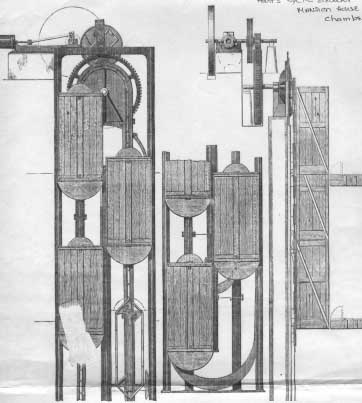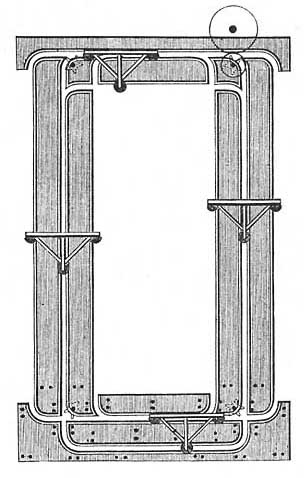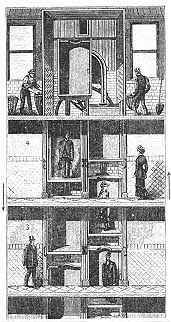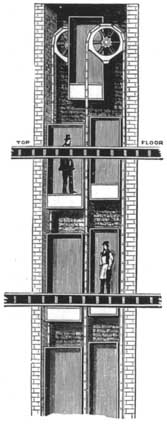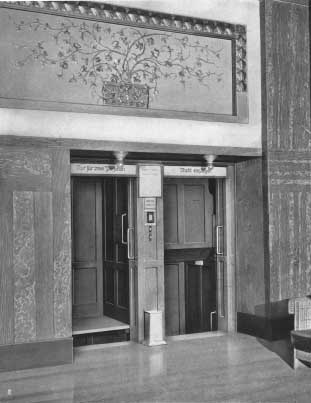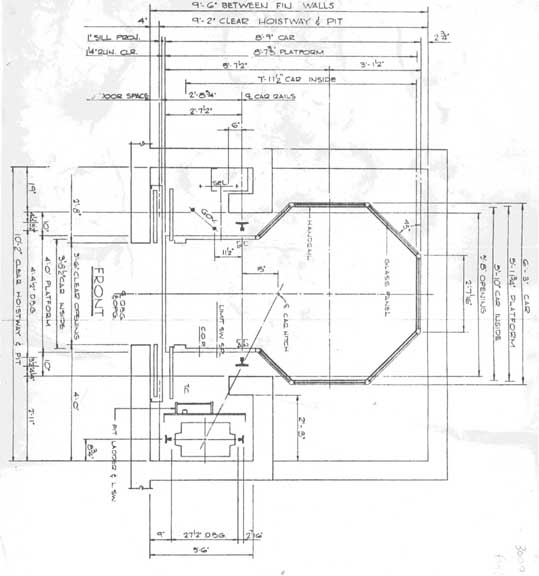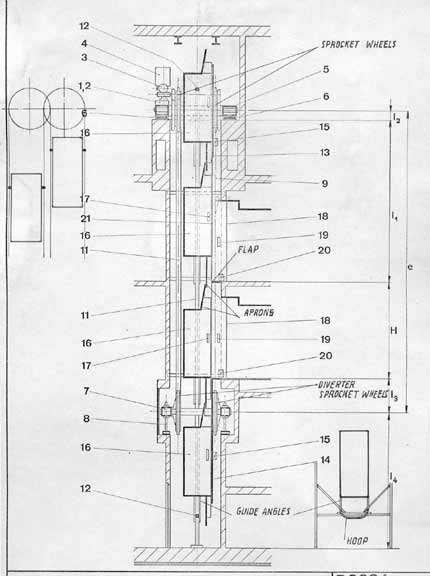|
(f-1-14, f-1-7, f-1-10, f-1-13)
|
|
In 1884, Londoner J.E. Hall developed the first paternoster.
It was driven by a steam engine and called "J.E. Hall's Cyclic
Elevator." The newspaper described the system as having,
"an endless chain of cabins moving at a moderate speed; some
passing downward past a line of entrances and other cages moving
upward past another set of openings. Passengers may embark or
alight at any floor whenever they please, without delay. The rates
at which the cages move renders the getting on or off a matter
of no difficulty whatever. One very special feature about the
cyclic lift is that, by an ingenious mechanical arrangement, the
cages pass to the extreme height of the lift and then descend
without losing their vertical position, so that in case a passenger
omits by inadvertence, or otherwise, to get out at the intended
place, he is in no sort of danger. A small, horizontal engine
drives these elevators by friction and spur gearing, a comparatively
small amount of power being required, as the cages counterbalance
each other, and all descending traffic of course assists the engine.
There is also a special combination of governor and brake, which
effectually prevents the possibility of the lift racing. This
might otherwise occur if heavily laden on its descending side.
The floors of all cages are proided with flaps, as also are the
landings on the ascending side, thus preventing any possible accident
from anything projecting from a cage. Several of these elevators
have been erected by Messrs. J.E. Hall, and are at present time
working at the Kensington Palace Mansions; at Glasgow Herald Office,
Glasgow; at Mansion House in Chambers; in the Bourse Buildings
in Bucklersbury; and other places in the city of London. At the
two latter addresses, they are daily at work in the ordinary course
of business. One in Size Lane undoubtedly carries more people
daily than any other lift in London, the average number of passengers
from the bottom to the top floors being about 2000 per diem, exclusive
of those entering at the intermediate floors. The offices in the
top floor were let, we are told, as readily as the bottom floors,
and a restaurant on the fourth floor apparently does a good trade.
Lavatory accomodation for the entire building is also on the fourth
floor, thus effectually preventing any annoyance from objectionable
odours arising therefrom, without any reduction of convenience.
In watching the elevator at work, we have seen ladies and elderly
gentlemen avail themselves of it without hesitation."
(Graphic Source: Der Fahrstuhl)
|
|
 |
 |
(f-1-15, f-1-4, f-1-5, f-1-6)
|
|
Stigler paternoster in Vienna. Note the hand holds on the cabins
and entrances to assist in swift, safe passenger transfer.
(Graphic Source: Stigler)
|
|
 |
(f-1-16, f-1-17, f-1-18, f-1-19, f-1-20)
|
|
These photos were taken of old paternosters in Budapest that
were modernized in the mid-1950's. Little was changed in the hidden
mechanical drives. Photo 1 of upper machinery shows the track
around which the cabins move in an endless cycle. Photo 2 of the
lower machinery includes a large screw used to maintain tension
between the upper and lower track sheaves. One of the cards can
be seen making the turn at the bottom. Two pair of paternosters
were modernized and refinished. All are provided with baffle plates
between cars to prevent a fall into an open hoistway. Handholds
are easily accessible and one young lady in Photo 5 is shown pulling
a safety handle, much like the cord on a train, to stop the machinery.
A person or object caught in the opening will exert pressure on
the safety edges at the front of the car floor and the car top
and stop the relatively slow moving line of cabins.
|
|
 |
|
|
Continuously operating endless belt lifts were designed for
grain silos, car parks and other limited access areas. Such
rapid delivery equipment was meant only for well-trained house
personnel. Hoods at the floor openings are required on such
equipment used in modern times.
(Graphic Source: Systemy a Prostredky)
|
|
|





